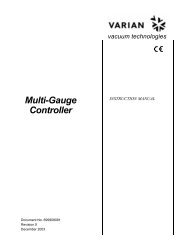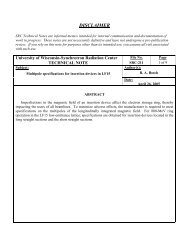SRC Users' Meeting - Synchrotron Radiation Center - University of ...
SRC Users' Meeting - Synchrotron Radiation Center - University of ...
SRC Users' Meeting - Synchrotron Radiation Center - University of ...
Create successful ePaper yourself
Turn your PDF publications into a flip-book with our unique Google optimized e-Paper software.
NEW FEATURES IN THE PHASE DIAGRAM OF CUPRATES<br />
Adam Kaminski<br />
Department <strong>of</strong> Physics, <strong>University</strong> <strong>of</strong> Wales Swansea, United Kingdom<br />
One <strong>of</strong> the most intriguing properties <strong>of</strong> the cuprates is their generic phase<br />
diagram, where high temperature superconductivity occurs in the<br />
proximity <strong>of</strong> a metal-insulator transition. The understanding <strong>of</strong> the various<br />
phases and their connections is deemed to be the key to solving the<br />
problem <strong>of</strong> high temperature superconductivity. We have used Angle Resolved<br />
Photo Emission Spectroscopy (ARPES) to address this problem. By studying<br />
the temperature dependence <strong>of</strong> the bilayer splitting we have found evidence <strong>of</strong><br />
a cross over between coherent and incoherent electron behavior - long anticipated<br />
by a number <strong>of</strong> theoretical models. We have also shown that a<br />
pseudogap exists on the overdoped side <strong>of</strong> the phase diagram below T c , when<br />
the superconductivity is suppressed by application <strong>of</strong> a sufficiently high<br />
current density. However, above certain doping, the pseudogap is<br />
no longer observed under the superconducting dome. This may indicate existence<br />
<strong>of</strong> a Quantum Critical Point (QCP) at a doping level between 0.2 and 0.25 holes per Cu atom.<br />
Existence <strong>of</strong> such point could mean close relation between cuprates and<br />
in heavy fermion compounds, where QCP is usually surrounded by dome <strong>of</strong> superconductivity.<br />
These results are instrumental in choosing a viable theoretical model <strong>of</strong> high temperature<br />
superconductivity.
















